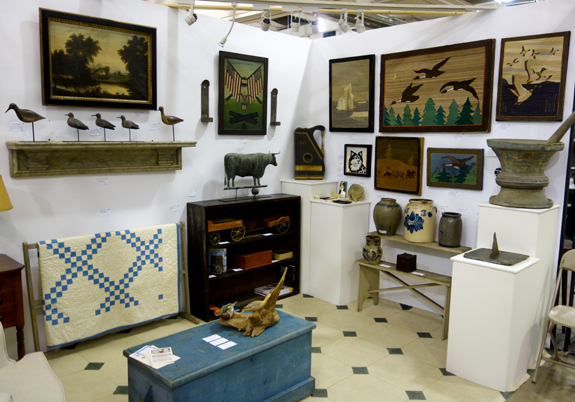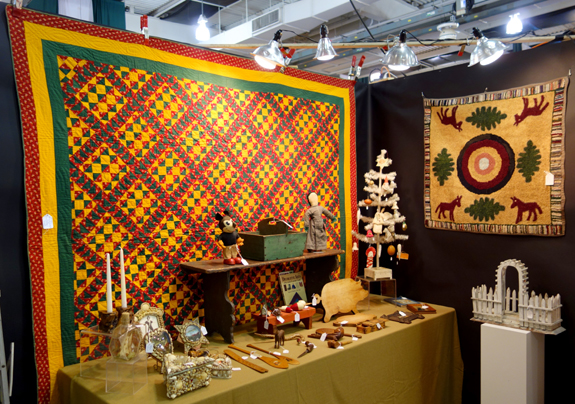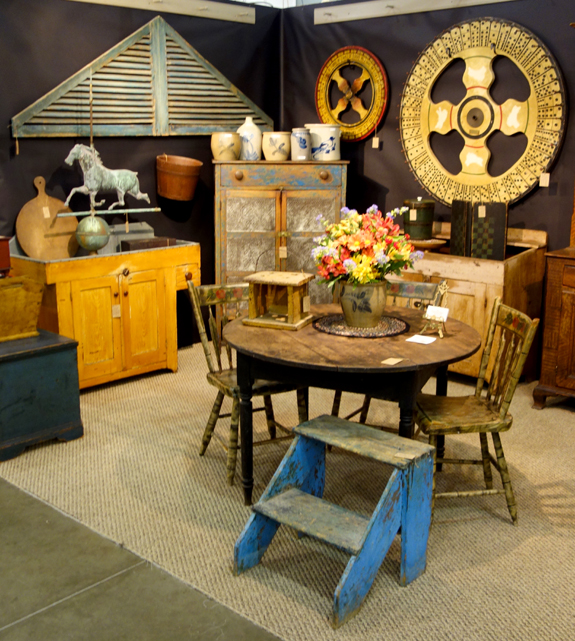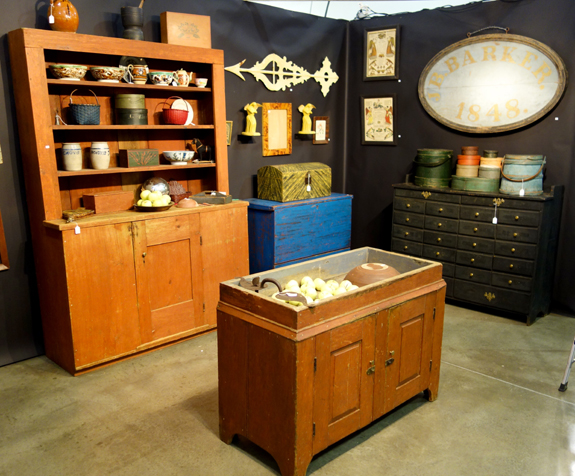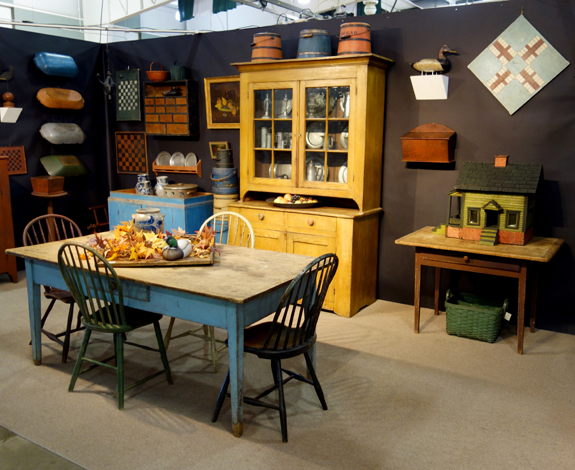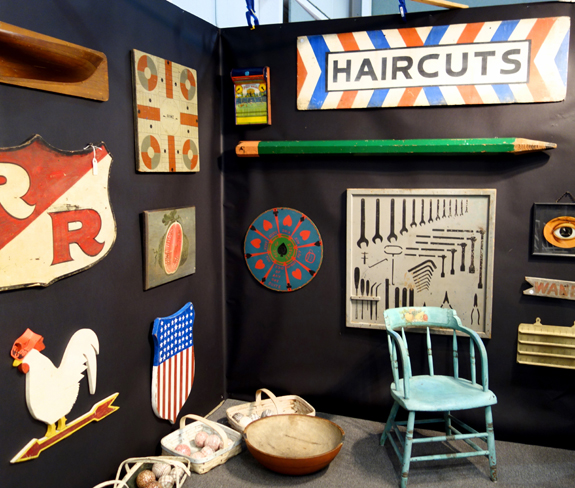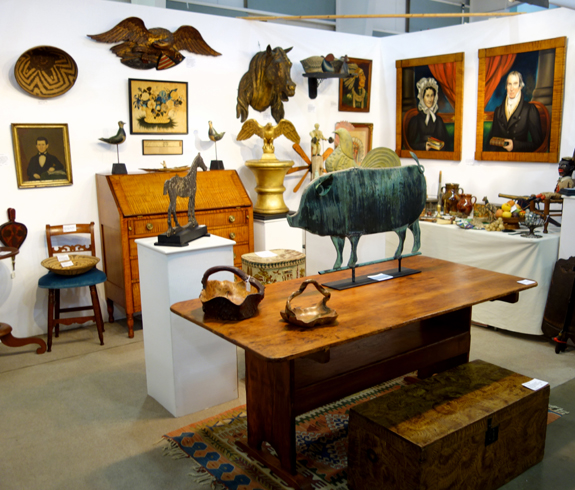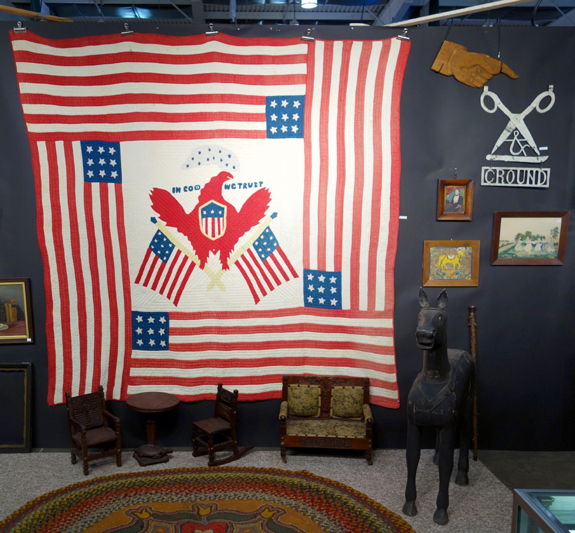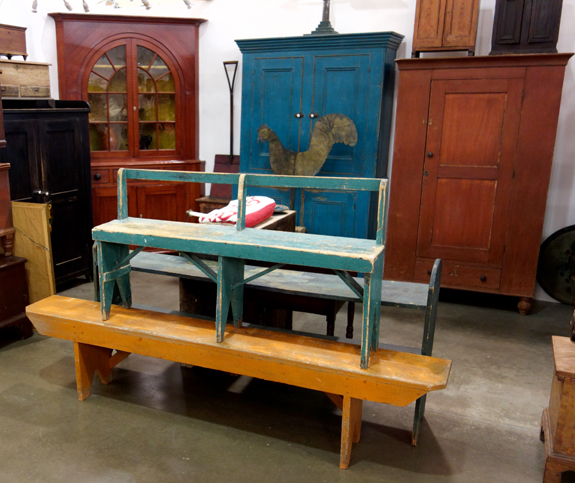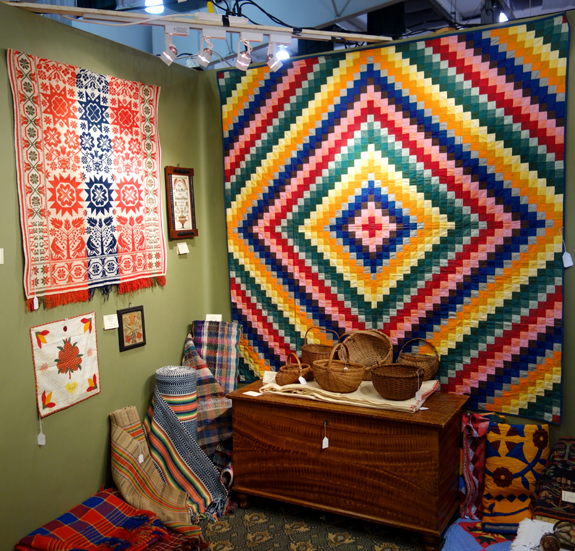Review and Photos by R. Scudder Smith
YORK, PENN. — If you want to talk about a very busy town, think about York, Penn. On Friday, September 25, a large crowd made its way to the fairgrounds, Memorial Hall East, to attend the 165th semi-annual York Antiques Show under the management of Melvin “Butch” Arion.
To get there, one had to weave a path through countless motorcycles on the roads, all either out for a spin or on the way to the town’s large Harley-Davidson factory. Special tours were being given there and one of the riders mentioned that 1,200 people were on hand for one of the early tours. The bikes and riders ended up, over the weekend, at the fairground’s race track. On top of all that, Memorial Hall West, in the same building as the antiques show, was being populated by train collectors and dealers for a show happening the same weekend.
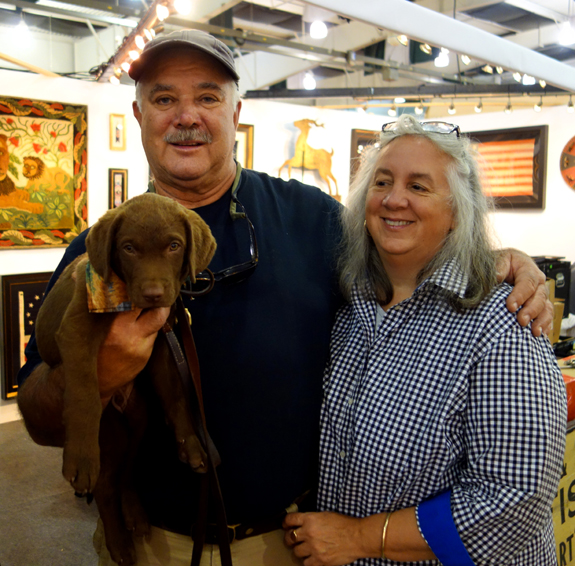
Hilary and Paulette Nolan have become proud parents again, this time to Musket, their new puppy. “I generally do not come to the show in York, but I did this time because we picked up Musket on the way down and he needs his new mother right away as he is only eight weeks old,” Paulette said.
For the antiques show, there was really only one hitch. “The fairgrounds would not release Memorial Hall East to us on Monday, the routine for years, but held us off until Tuesday to begin setting up the walls and preparing the space for the exhibitors,” Butch said. This delay then cut the setup time for the dealers from two complete days to only one. However, about 65 dealers were able to get into the building late in the day on Wednesday when the walls were finished. A number of those dealers began to unpack and set up, while others just unloaded trucks and vans and left the setup until morning.
Despite the shortened time, the show opened on schedule at 10 am Friday, closing at 6 pm, with a large first-day attendance. “There was a drop off, more than ever before, in the attendance on Saturday and Sunday, and I don’t know why,” Butch said. He did mention that he sent tickets to some of the collectors he knew in Philadelphia, and none of them came. At that time travel in Philadelphia was not easy with the Pope visiting the city.
Those who did come, however, seemed happy with what they found and there was the first rush around the floor and then the slower trip to check for things missed. And there was lots to buy. Both dealers and visitors agreed that the show looked well, was filled with interesting things, and many dealers reported good sales.
Check out the show on this article, and then remember to have a closer look next January.
Seven weathervanes were scattered about the booth of James Wm. Lowery, Baldwinsville, N.Y., including a rooster, pig, sheep, cow, eagle and two horses, one of them a hackney dating from the Nineteenth Century and measuring 32 inches long and 24 inches high. At the back of the booth was a Connecticut Queen Anne highboy, probably Middletown, circa 1740–60, with a carved fan in the lower case and resting on cabriole legs.
Richard “Smitty” Axtell of Deposit, N.Y., was in his regular corner booth spot with a 78-inch-long Windsor settee in the original mustard paint across the front of the booth and a row of ten lanterns, including several of punched tin, a canal lantern and several fluid burner examples, hanging from pegs across the right side wall. A large, colorful floral design hooked rug took up a good deal of wall space, and a wonderful cake board was carved with the image of George Washington on horseback.
The Hanebergs Antiques, East Lyme, Conn., drew attention to their booth with a St Julian weathervane by Fiske, depicting a horse, sulky and driver Orrin Hickok, 40 inches long and dating circa 1881. Against the back wall was a brass inlaid camphor wood Chinese campaign desk, circa 1850, and over it hung a girandole mirror, circa 1815, 36 inches high with an eagle on top.
A red, white and blue patriotic quilt filled the back wall at the booth of Scott Bassoff / Sandy Jacobs, Swampscott, Mass., with an eagle, In God We Trust, centered and four flags forming the border. Standing in front of it was a wood carved standing horse, black painted, about 4 feet tall, possibly a carousel figure from a small machine. A ship’s figurehead of a vested man was positioned in the corner, with a hooked rug showing a colorful basket of flowers.
A sign advertising Bransfield’s Tavern, Frankenberger, yellow lettering on a black ground, dominated the back of the booth of Jewett-Berdan, Newcastle, Maine, with an early sorting table in apple green paint positioned under it. One of the hooked rugs shown depicted a standing black dog on a rose background, and an eagle weathervane with very good verdigris surface was on a corner pedestal. “That weathervane, we just got and it has a real wonderful surface and look,” Tom Jewett said, adding, “It came right off a Long Island estate.”
If you were shopping for a set of four very sturdy, Windsor-style armchairs, white paint, then Douglas R. Wyant of Cassopolis, Mich., had the answer. He also had the answer for early sign collectors with examples displayed on all three walls of his booth. One sign noted “Haircuts,” while another suggested a “Garage For Rent.” Another hand drawn sign advertised “Golden Bantam Sweet Corn” and included the costs: “10 cents per doz or 2 doz. — 25 cents.” One had to question the math, but the explanation was easy. “They once had a 5 in place of the 0, but when they overpainted it they did nothing about the better deal below,” Douglas said.
Peter W. Chillingworth, Scenery Hill, Penn., offered a pair of Windsor bowback side chairs in black, and a selection of iron implements, including a peel, nice Betty lamp and double calipers. A cast iron arbor, circa 1910, took up most of the floor space in the booth of B. Hannah Daniel, Athens, Ga., which came apart in 13 pieces. “It is easy to move about and when I saw it I knew that I had to have it. And it sold during the first part of the show,” she said.
Dennis and Valerie Bakoledis of Rhinebeck, N.Y., surrounded a table with a set of six English chairs with rush seats, one arm and five sides, and on the wall was a Nineteenth Century pine whale-end shelf with two drawers under the bottom shelf. A cast iron trammel, Queen Anne and dating from the Eighteenth Century, was large with extra decoration at each end.
Oley, Penn., exhibitor Bertolet House Antiques showed a round farm table, Pennsylvania, circa 1860-80, in the original black paint with scrubbed top, and also from Pennsylvania was a 15-pane Dutch cupboard, circa 1830. A large game wheel with dice decoration dated circa 1940.
An early farm table with two-board top, breadboard ends and stretcher base was at the front of the booth of John H. Rogers, Elkins, N.H., and displayed on it was a very large burl bowl, with wooden paddle. Dating from the Nineteenth Century was a two-part stepback cupboard, old red paint, measuring only 26 inches wide.
A Bird In hand, Florham Park, N.J., showed a mortar and pestle apothecary trade sign, metal, circa 1840–70, measuring 30½ inches high and 18½ inches in diameter. In addition to a large selection of carved and painted birds, a standout was a model steamship by Lloyd J. Tyler (1898–1970) of Crisfield, Md., a known decoy maker. It retained the original painted surface and the small carved pilot house eagle on the front of the boat was still intact.
Pratt’s Antiques, Victor, N.Y., had a fancy cast iron gate, painted red and white with a row of seven stars across the top, that came out of Buffalo, N.Y., circa 1900. Three New England storage boxes with staved construction and lids retaining their original paint — one blue, one red and one mustard — were stacked on a New York State bench table, painted base and scrubbed pine top, circa 1840, and large enough to seat ten people. A few colorful comic figures in cutout wood, including Popeye, stood in the corner of the booth.
A hitching post in the form of a saddle boy, cast iron, dressed in blue and yellow and dating from the Nineteenth Century, was in the booth of Joseph J. Lodge, Lederach, Penn. “He is complete with his separate cast iron cap and it is a wonder that it has not been lost after all these years,” Joe said. A grain painted single-door cupboard, 30 inches wide, circa 1860, was in all-original condition, and an Eighteenth Century tap table, country Queen Anne, circa 1785, had a one-board top of tiger maple with breadboard ends.
Heller Washam, Portland, Maine, filled a large booth at the front of the show with many pieces of furniture, including a New England rectangular top tea table, circa 1730–80, probably Rhode Island, and an applewood farm table, Valley of Virginia, circa 1800, with a single board top, breadboard ends, measuring 66 inches long and 32 inches wide.
Steven F. Still Antiques, Manheim, Penn., hung an American tin and wood ten-arm chandelier at the front of his booth, a piece dating from the early Nineteenth Century from the estate of Fred Woolworth, Monmouth, Maine. By far the largest ship model in the show was of the Kearsarge, a steam ship built at the Portsmouth Navy Yard in 1861. The model, measuring 8 feet long, was built with a live steam engine.
A mid-Nineteenth Century walnut and pine 48-drawer apothecary from the general store building in Shanesville, Penn., was against the back wall in the booth of Salt Box Antiques, Sugarloaf, Penn., and at the front was a Queen Anne Eighteenth Century worktable in cherry, with three-board top and cabriole legs.
An attention-getter in the booth of Garthoeffner Gallery, Lititz, Penn., was a large base drum from the Hobo Band, Pottstown, Penn., a group that was organized August 22, 1931, with a large, colorful, bearded pipe-smoking character pictured in the center. Two hooked rugs hung on the walls, a Palomino pony, wool on burlap, circa 1910, and another with horses, also wool on burlap, circa 1870.
James M. Kilvington, Greenville, Del., brought a Philadelphia Chippendale side chair, circa 1770, and a Chester County Queen Anne tea table, circa 1765. A game board, checkers, was an interesting combination of colors with black squares on a yellow ground, surrounded by a green painted frame.
Red tags dotted the booth of Thomas M. Thompson, Pembroke, N.H., attached to a framed silhouette of a cat, an early screen cover for foods, a large cutting board, a trencher strainer and a redware flower pot. One lady was elbowing her way into the booth saying to Tommy, “I always go through everything in your case.” And she did.
“We have had a good number of people look at that chair,” Stephen Corrigan of Stephen-Douglas, Rockingham, Vt., said while pointing out a low back Windsor with dark surface. He noted that “with that low back it could very well have been used by a cobbler or someone working low.” Early sales included a hutch table from Kennebunk, Maine, circa 1810, a decorated hook rug, several painted boxes and an early cat squeak toy.
Philip H. Bradley of Downingtown, Penn., showed a New England ball foot chest, probably Eastern Connecticut or Rhode Island, circa 1740, and a Philadelphia candlestand in mahogany, circa 1770, 28¼ inches high and 20½ inches in diameter. A gray painted, hard pine stretcher base table, dating from the mid-Eighteenth Century, originally blue painted, was possibly a New Jersey piece.
Jeff R. Bridgman American Antiques, Historic York County, Penn., had his usual interesting collection of flags and other patriotic pieces, and in addition offered a game wheel in mustard paint with ten cast zinc horses and riders attached and ready to race to the finish. It dated circa 1880. A sheet metal deer weathervane of large size, old yellow paint, was shown high on the back wall, rearing as if he was about ready to clear the wall.
Gallerybfa, Scott Brasseur, Prospect, Penn., showed a large oil on canvas of a piece of Caterpillar equipment on a bright yellow ground, signed Vaughn, circa 1938, and a very colorful and bright Indian blanket in red, white and blue. A Hambletonian horse weathervane sported a fine verdigris surface and zinc head. Nearby, Bruce Rigsby Antiques, Lancaster, Ky., offered a pair of decorated canoe paddles, a well-carved pull toy with two white horses, and a selection of four different sizes of Noah’s Arks, with a limited number of animals and figures.
Thomas Longacre, Marlborough, N.H., had a lift lid, canted front storage or grain bin with the original shoe feet and blue/gray slate-colored painted surface. It dated circa 1820 and was found in central New Hampshire. “Gladiolus For Sale” was on an early sign, black lettering on white ground with a red frame, and a working pond boat with the original sail, dated circa 1880–1920, was from Vermont. And Christmas was alive and well in Beverly’s corner of the booth.
Samuel Forsyth, Columbia, Ohio, had a stepback cupboard in the original red paint against the back wall of the booth, and it was filled to capacity with redware pottery, two punched tin coffee pots, other smalls and a row of baskets on top. A selection of iron was in the corner with a few lighting devices, a Betty lamp on stand and a wrought iron toaster.
The showcases at American Sampler, Barnesville, Md., were filled with some mechanical and still banks, as well as a large selection of doorstops, including dogs, rabbits, a turkey, three kittens in a basket, a couple more cats, ducks and an owl. A pair of cast iron figural andirons featured flying ducks.
Kelly Kinzle, New Oxford, Penn., had a selection of furniture, including a decorated card table, Baltimore, circa 1815, attributed to Thomas Renshaw with decoration by John Barnhart, painted pine and mahogany veneer. Against the back wall was a Pennsylvania walnut two-piece stepback cupboard with rattail hinges and dating circa 1800. For the collectors of early advertising pieces, Kelly had a Heinz Ketchup bottle, complete with the old label, measuring about 14 inches high.
A pair of cast iron recumbent garden dogs, American, mid-Twentieth Century, measuring 20½ inches long, stood watch in the booth of Samuel Herrup, Sheffield, Mass. A picture of an unknown ship by Thomas Willis (1850–1920), circa 1900, signed lower right, in the original frame, measured 22 by 25¾ inches, and an English doll’s bed in mahogany, mid-Nineteenth Century, retained the original cotton chintz bed coverings in blue with baskets of flowers design.
Bill Kelly of Limington, Maine, brought a red painted stepback cupboard that was filled with mocha, painted boxes and a bowl filled with green apples, and more green apples brought out the red color of an early dry sink. For miniature furniture collectors Bill had a rolltop desk in old red with some striping decoration.
James and Nancy Glazer of Bailey Island, Maine, offered a set of six decorated fancy side chairs, New York, circa 1810, with button feet and red paint and gold decoration, as well as a miniature Mahantongo chest, dated 1842, Centre County, Penn., stamped and freehand decoration. At the front of the booth was a Cedar Rapids lazy Susan, marquetry oak, drop leaf side table that tells the history of the town, including buildings and population. It dates circa 1911.
The next York Antiques Show & Sale, under the management of Butch Arion, will be January 29–31 in Memorial Hall East on the York Fairgrounds. For information, www.theoriginalyorkantiquesshow.com or 302-875-5326.

